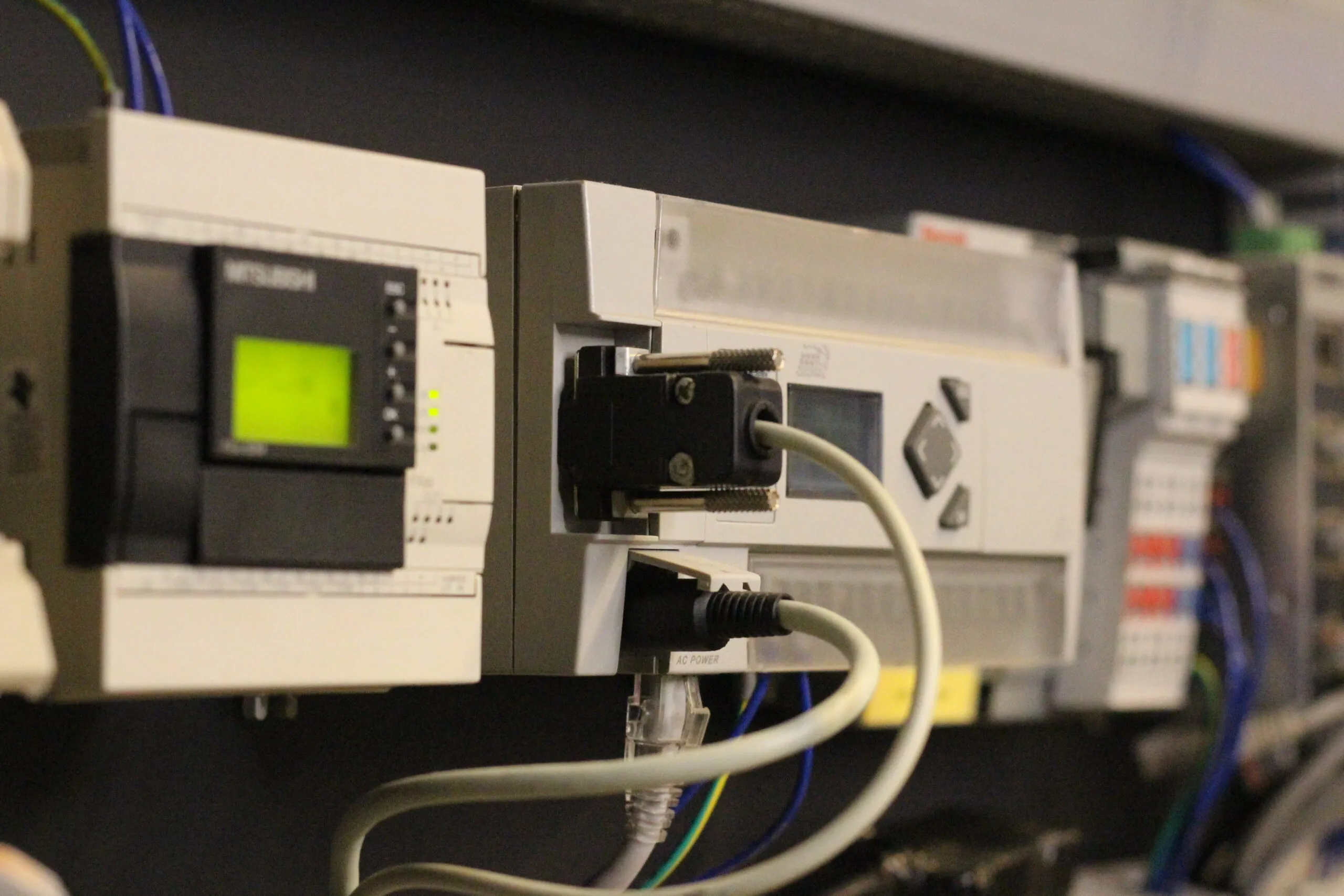Programmable Logic Controllers (PLCs), conceived in the 1960s in the USA to replace complex electromechanical control systems then prevalent in the automotive industry, emerged as a disruptive solution. General Motors spearheaded their adoption, aiming for operational agility and robustness. The Modicon 084 marked the commercial debut, enabling logical reconfiguration via software, eliminating physical interventions. Since then, the continuous evolution of hardware and software has solidified PLCs as essential elements in contemporary industrial automation.
Programmability defines the core capability of PLCs, providing dynamic adaptability through customized logic in software. Their robust architecture integrates a high-performance CPU for rapid processing of complex tasks, I/O modules for concurrent data acquisition and precise peripheral control, resilient power supplies for uninterrupted operation, and versatile communication interfaces for systemic integration and scalability.
The heterogeneity of protocols in industrial plants stems from technological evolution and the proliferation of specialized machinery. Standards such as OPC-UA and MQTT, superior in flexibility and integration to legacy systems like Modbus and RS232, have gained adoption. The specialization of machinery introduced optimized protocols, such as Fanuc CNC, and proprietary ones, like Mitsubishi Melsec. This coexistence of distinct protocols within the same production environment underscores the necessity of interoperability.
Communicational flexibility offers crucial strategic advantages: unrestricted interoperability in equipment selection; facilitated scalability through the addition of new devices with minimal reconfiguration; agile adaptability to emerging technologies and IoT; seamless integration with enterprise systems (like Historian) for operational optimization; and robust security through advanced protocols ensuring the integrity and protection of industrial data. In summary, multi-protocol communication capability is fundamental to the efficiency, scalability, and security of modern manufacturing operations.

Communication Between Industrial Machinery and PLCs
Communication protocols enable the connection of PLCs to diverse devices and systems, such as actuators, HMIs, and other PLCs. They operate as a set of rules that standardize the transmission and reception of data between elements. The flow of this communication encompasses the following steps:
- Protocol Selection: Initially, the appropriate communication protocol for the application is defined. Modbus, Profibus, and Ethernet/IP are common examples.
- PLC Configuration: The PLC is configured to employ the selected protocol, which may involve installing specific communication modules and parameterization via software.
- Sensor Data Acquisition: The PLC collects data from connected sensors and input devices, covering information such as temperature, pressure, and position.
- Data Processing: The PLC’s CPU processes the data according to the resident program, making decisions based on the defined control logic.
- Data Formatting: The processed data is formatted in accordance with the communication protocol specifications, ensuring intelligibility for other devices on the network.
- Data Transmission: The data is transmitted by the PLC’s communication module to the network or directly to other devices. In Ethernet networks, for example, it can be sent to a SCADA server or Historian
- Command Reception: The PLC also receives commands from other devices or control systems, instructing it to alter logic, adjust parameters, or execute specific actions.
- State Update: The PLC updates its internal states and the states of connected devices based on received feedback.
Data Integration Across Different Areas in a Manufacturing Plant
Each industrial sector adopts specific PLC models, selected based on environment, complexity, and cost. The most common communication protocols per sector include:
- Automotive: CANopen, due to low latency and high reliability for real-time control; and DeviceNet, based on CAN for interconnecting devices in machine control systems.
- Food & Beverage: Ethernet/IP, offering fast and efficient communication essential for high-speed data processes; and Profinet, utilized for real-time communication, ensuring precise synchronization of critical processes.
- Chemical: Profibus, applied in chemical plant control processes due to its robustness and resilience to harsh environments and interference; and Modbus, ideal for simple and robust communication between sensors and industrial controllers.
- Pharmaceutical: Modbus, employed in communication between laboratory equipment and process control systems; and Ethernet/IP, enabling the integration of real-time control and monitoring systems, crucial for quality and compliance.
- Pulp & Paper: Profinet, fundamental for real-time synchronization of production processes; and Profibus, whose robustness is suitable for challenging industrial environments.
Considering a complex manufacturing scenario, such as in the automotive industry with its intricate production lines and multiple control systems, the coexistence of various communication protocols is common. Assembly robots may operate via EtherCAT, temperature and pressure sensors via Modbus, motor controllers via CAN, and quality inspection systems via Profibus.
In this context, implementing a solution capable of supporting multiple protocols becomes essential. This device centralizes the real-time data collection from all machines, regardless of their native protocol. The unified data is then directed to a manufacturing management system, providing a holistic view of the production line.
This integration enables the proactive identification of issues, such as temperature deviations or robotic failures. The factory, equipped with centralized and analyzed data, can implement precise corrective actions, such as adjustments to motor controllers and predictive maintenance.

Importance of Compatibility with Diverse Protocols
The various industrial communication protocols enable the connection and communication of PLCs with sensors, Human-Machine Interfaces (HMIs), and other devices, being fundamental for the integration and interoperability of automation systems.
This connectivity is crucial, as reading the data generated by machinery reveals valuable insights for industrial operations. Beyond real-time production monitoring, essential for performance and productivity analyses, the storage of historical data is equally indispensable. This visibility enables:
- Operational Efficiency Optimization: Data access allows for better resource utilization, reduced downtime, and increased productivity.
- Predictive Maintenance Implementation: Helps prevent unplanned shutdowns, reduce repair costs, and increase equipment lifespan.
- Product Quality Enhancement: Reduces the quantity of defective products and improves customer satisfaction.
- Cost Reduction: Analysis of collected data helps identify areas where costs can be reduced (energy consumption, raw material usage).
- Assertive Decision-Making Improvement: Enhances the ability to respond to changes in operational conditions.
The future trend points towards the increasing adoption of Ethernet-based protocols, due to their high speed and simultaneous communication. Integrated with IoT solutions, which allow for scalable data storage in the cloud, this technological landscape should drive efficiency, security, and rapid response capability to operational adjustments in the coming years.
Learn more about ST-One.